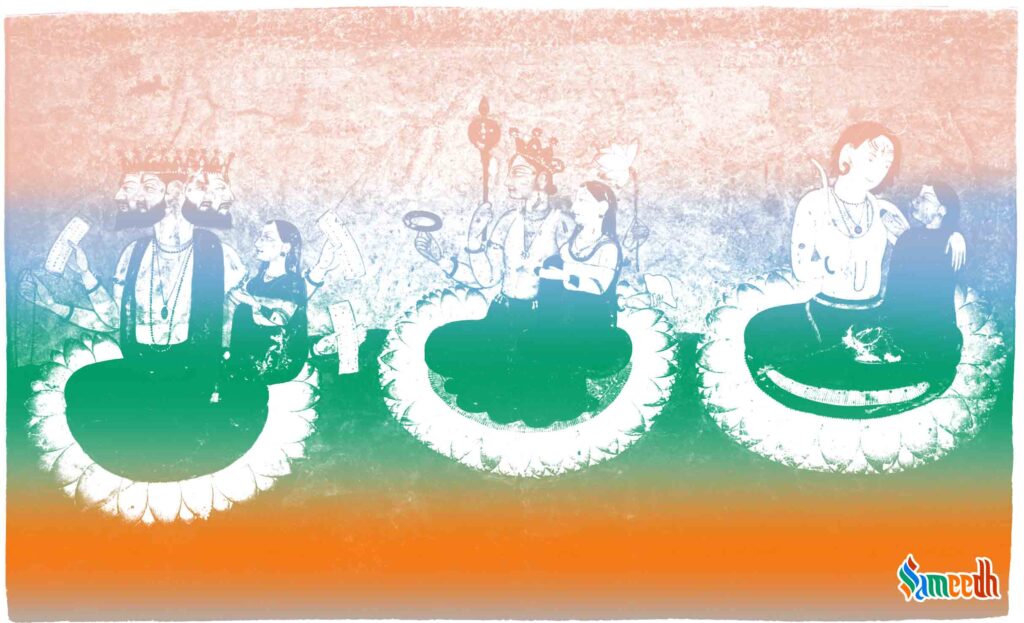The significance of having 33 crore gods in Hinduism.

Brahma, Vishnu and Shiva seated on lotuses with their consorts Saraswati, Lakshmi and Parvati; Image Source: V & A
ORIGIN
Hinduism is often known as a polythestic religion with countless gods and goddesses to worship, but there are more facets to it which would be uncovered. It is the third most practised religion in the world. A core belief of Hinduism is such that a supreme force lies within every entity. Every man, woman and even object has a life and hence carries a living force. This living force is the superior power which has been bestowed upon every existing being. Meaning, it is an all encompassing power. And yet, there is another aligned belief that this entire energy and power flow is panned out through one source, Brahaman. This is not to be confused with the Hindu deity of creation, Brahma. Brahaman is believed to be the driving power and force of existence. Everything emerges from it, there is no Universe of life without it. Brahaman has no form or shape either, it is Nirakar. There are no physical attributions associated with the power of Brahaman. The various gods and goddesses are known to be the manifestations of Brahaman.
SIGNIFICANCE
This form of worship promotes the comfort that God lives within each soul, he is near and attainable. There are multiple mythological anecdotes which depict how determined worship has led devotees to directly contact god. Two practices advanced by Hinduism are Meditation and Yoga. Through these techniques, Hindus have achieved the highest state of consciousness and felt the closest to higher power through an awakened understanding of the world and energy.
HISTORICAL PRACTICE
There are three deities responsible for the creation, preservation and destruction namely Brahma, Vishnu and Shiv respectively. Together they are known as the Trimurti and known as the chief gods.
Then there are various schools of worship in Hinduism. Vaishnavism refers to the worshippers of Vishnu. These devotees primarily worship only forms and various avatars of Vishnu. Although they do not have anything against other deities, their devotion remains loyal towards manifestations of Vishnu. Most followers of the Hindu religion practice Vaishnavism.
Shaivism is the worship of god Shiva. The followers call themselves Shaivas or Shaivites. Then comes Shaktism where Shakti translates to energy. Shakti is known as the mother goddess and her followers believe in the supreme role of energy in the Universe and how everything stems from it and is facilitated by it. Smartism is too recognised as a belief where Smartas, the ones who value all deities equally, are pertained. They holistically encourage devotion towards all the deities. They have a liberal viewpoint and essentially indicate how free a religion Hinduism is. It does not force its devotees to follow a particular deity, they are free to choose who they want to worship. It does not even necessarily have to be a god, it can simply be the faith in supreme powers that led to the creation, preservation and destruction of the Universe.
PRESENT DAY USAGE
Although there is a belief that there are 33 crore gods and goddesses in Hinduism, it is known to be a misconception as the word “Koti” meaning type, is mistaken as crore. Hindus are at liberty to pray to any god of their choice, they can even simply devote themselves fully towards meditation to reach their goals.
METAPHYSICS
Hindus are widely appreciated for their scientific approach towards life. Here as well, there is a deeper reason. Any object or entity in nature that provides any benefits is often regarded as a god in Hinduism, there are fire, sun, water, wind etc gods. If a water body is regarded as sacred, people would refrain from corrupting or polluting it. They would in fact express gratitude towards it and preserve it. This idea is spread across various natural objects or bodies so people value things more efficiently, are able to identify its prime offering and never cause any harm towards it. It can be viewed as a holy way for preservation of natural resources.
